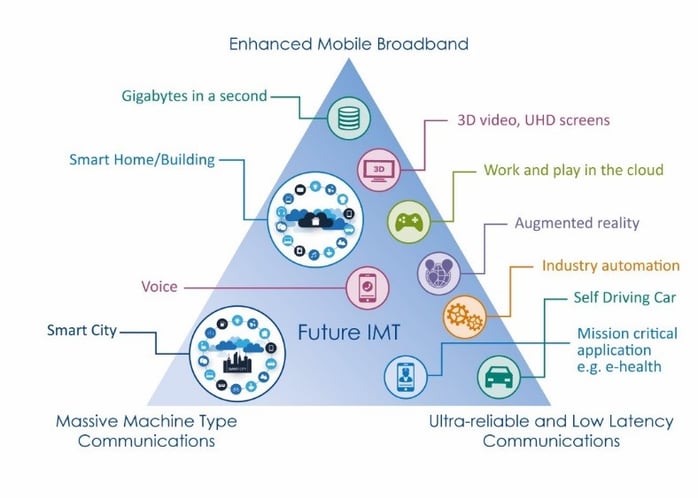There is little doubt that 5G will play a major role in our society’s future. As a veteran of the telecommunications industry who has developed generations of hardware and software, I have a deep appreciation for what 3rd Generation Partnership Project (3GPP) is doing with 5G, and am excited to see how it will change lives in the years to come.

Advancing IoT Connectivity: The Unique Strengths of 5G and LoRaWAN® Unveiled
Aligning Connectivity to Application Needs: Understanding Optimal Deployment Scenarios for 5G and LoRaWAN
5G offers a significant advancement over 4G technology, from the air interface to the core network. The result is a sophisticated and complex communication system. To help organize the capabilities, 5G has been broken into three main use cases: Enhanced Mobile Broadband (eMBB), Ultra-reliable and Low-latency Communications (uRLLC) and Massive Machine Type Communications (mMTC), or Massive IoT. As you can see from the diagram below, there are a broad set of technological capabilities being addressed, from low latency to high bandwidth and massive capacity. 
Photo Credit: International Telecommunications Union
As you can see from the diagram, one of the advantages of 5G is its incredible versatility in providing value into many industry verticals. After the spectrum auctions are complete, networks are deployed and devices are available. The number of customer applications supported by this will be enormous.
Conversely, the complexity and breadth of supported use cases means that some will be suboptimal due to 5G simply being “too much.” This opens the door for a “right-size” technology to support these applications and one can already see this happening in the market today. In my humble opinion, 3GPP made too many compromises with their low power wide area network (LPWAN) technology, making NB-IoT and LTE-M look like slimmed down LTE. This chink in the 3GPP armor is currently being exploited in the global LPWAN market where the open LoRaWAN® protocol has become the de facto solution for many applications. Looking forward, I foresee that 5G can narrow the technology gap to some degree, but there will always be room for a highly specialized networking technology like LoRaWAN.
LoRaWAN shares some of the strengths of 5G in that it leverages an open standard and a thriving global ecosystem, managed by the LoRa Alliance®. In contrast to 5G, LoRaWAN is a relatively simple networking protocol that has been designed from the ground up to serve distinct use cases. The prototypical use case for LoRaWAN is a battery-operated device that transmits several bytes of data at intervals of 15 minutes to an hour, and needs to last in the field for 10+ years without wires. The communication range can easily reach more than 10km, which is much longer than Bluetooth®, Wi-Fi, and millimeter wave 5G. LoRaWAN is not the right choice for applications that require streaming of video or voice calls, nor is it optimal for ultra-low latency applications. However, it is the optimal choice for what it was specifically designed to do and it accomplishes this efficiently and cost-effectively.

LoRaWAN serves a well-defined technological use case which can be utilized by many applications. Some of the most obvious applications are water, gas metering and smart parking where devices must be battery-operated, low cost, and last in the field for 10+ years. There are also many advantages to using Semtech’s LoRa® devices and wireless radio frequency technology (LoRa Technology) inside buildings to monitor everything from leaks to occupancy to comfort levels. Installing low-cost battery-operated devices inside a building is much less expensive than installing wired devices, or using a wireless technology ill-equipped for longer range and low power. 5G will experience the same challenges with signal propagation that 4G users experience today, impacting the ability of 5G signals to penetrate physical structures like buildings, though these problems will be worsened by the move to higher frequencies that comes with 5G.
Of course, 5G will serve an enormous number of applications but it will not be the best fit for every IoT use case. Particularly, the LPWAN sector will demand a solution with an extremely low total cost of ownership (TCO) for many business cases to be feasible. Several factors will affect the total cost of ownership equation beyond the obvious monthly connectivity fees and device cost. Provisioning, installation and maintenance fees will all play a major factor in the TCO. The difference between two and seven years of battery life could easily make or break the business model due to extra maintenance fees. Depending on the application, sometimes 5G will be the best fit and sometimes LoRaWAN.
At the end of the day, until 5G is more widely deployed and device hardware becomes available, one can only speculate how wide the gap will be between 5G and LoRaWAN. For many applications that are well served by LoRaWAN, the market does not need to wait. LoRa-enabled devices and LoRaWAN-based networks are here today and there are countless deployments with this proven and mature technology worldwide. From my experience, the customer wants a solution that works and meets their budget. They want intelligent parking, not 5G intelligent parking. They want to know if there is a leak in their building, not a 5G sensor that can detect leaks. LoRaWAN serves these applications very well, is available now, and will co-exist quite nicely with 5G for many years to come.
LoRa Alliance™ member eleven-x has deployed Canada’s first and only coast-to-coast LoRaWAN-based network for IoT. Learn more about their innovative networks, solutions and partners on the eleven-x website.

Semtech®, the Semtech logo, LoRa®, and LoRaWAN® are registered trademarks or service marks of Semtech Corporation or its affiliates. Other product or service names mentioned herein may be the trademarks of their respective owners.



